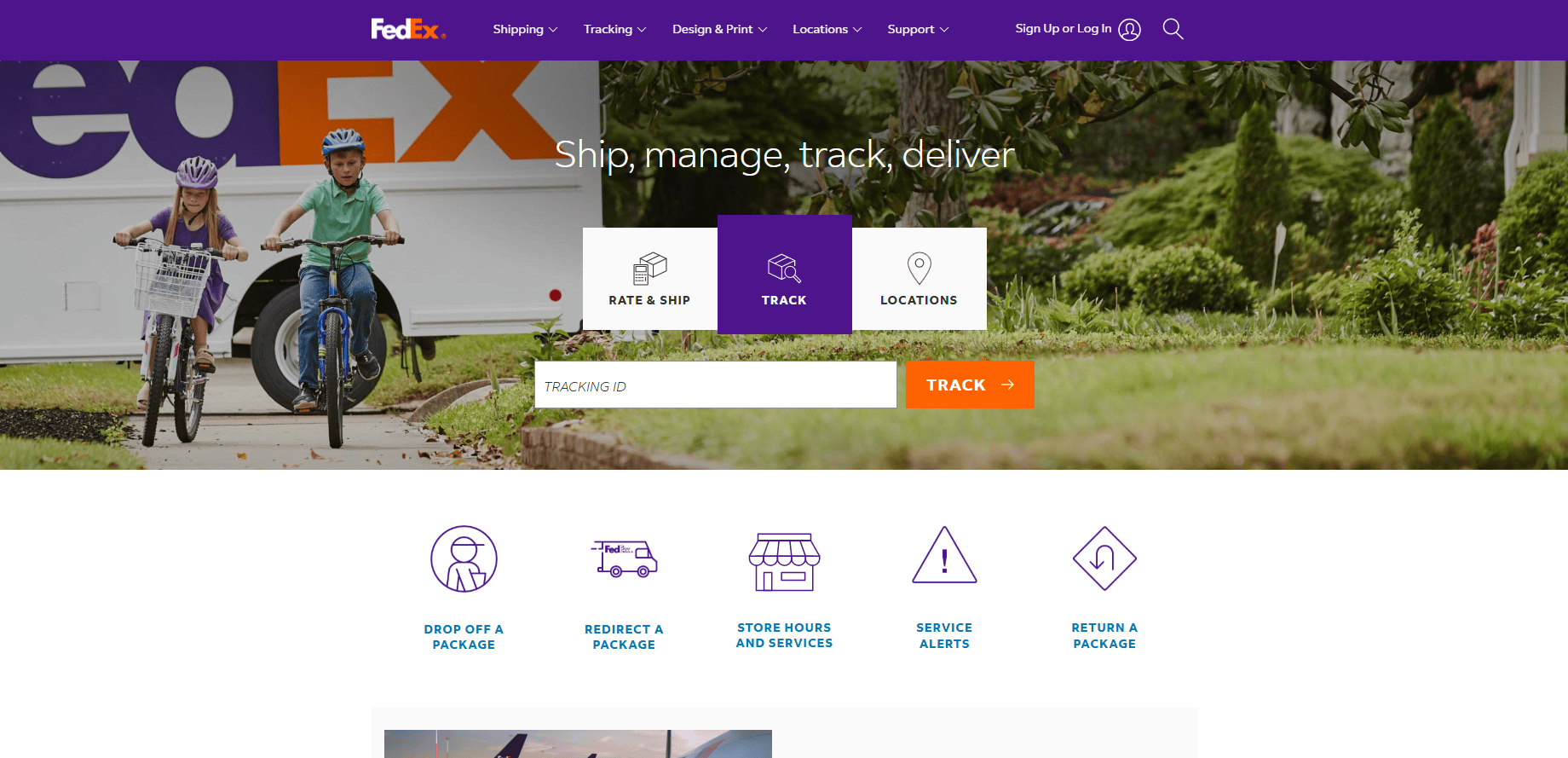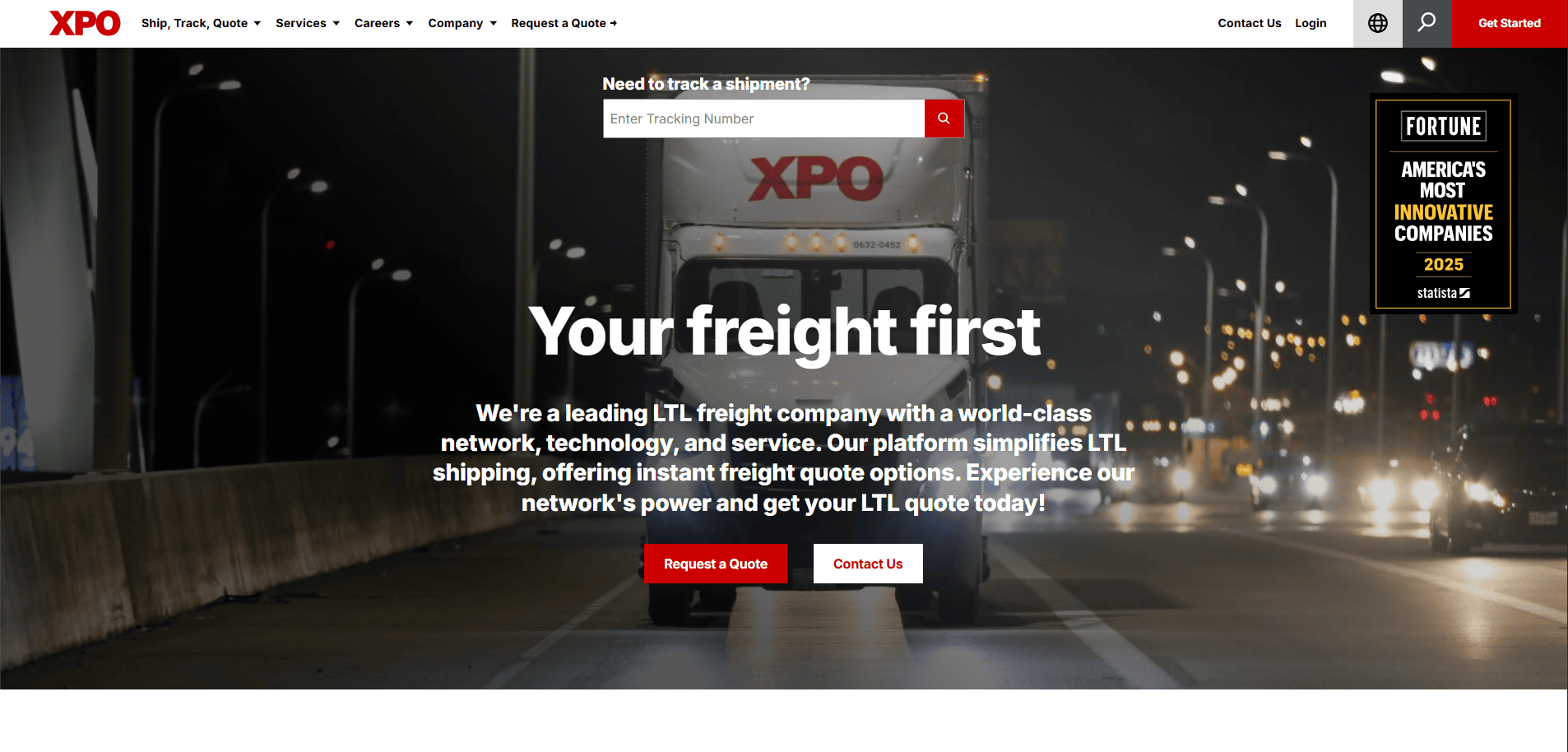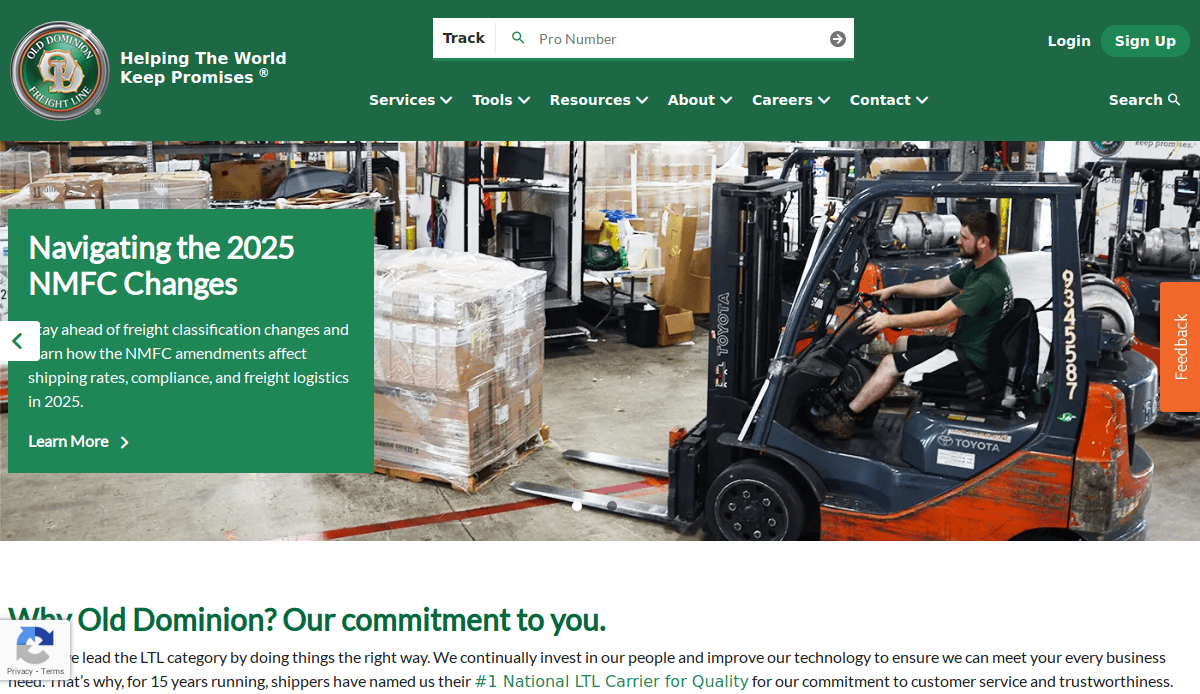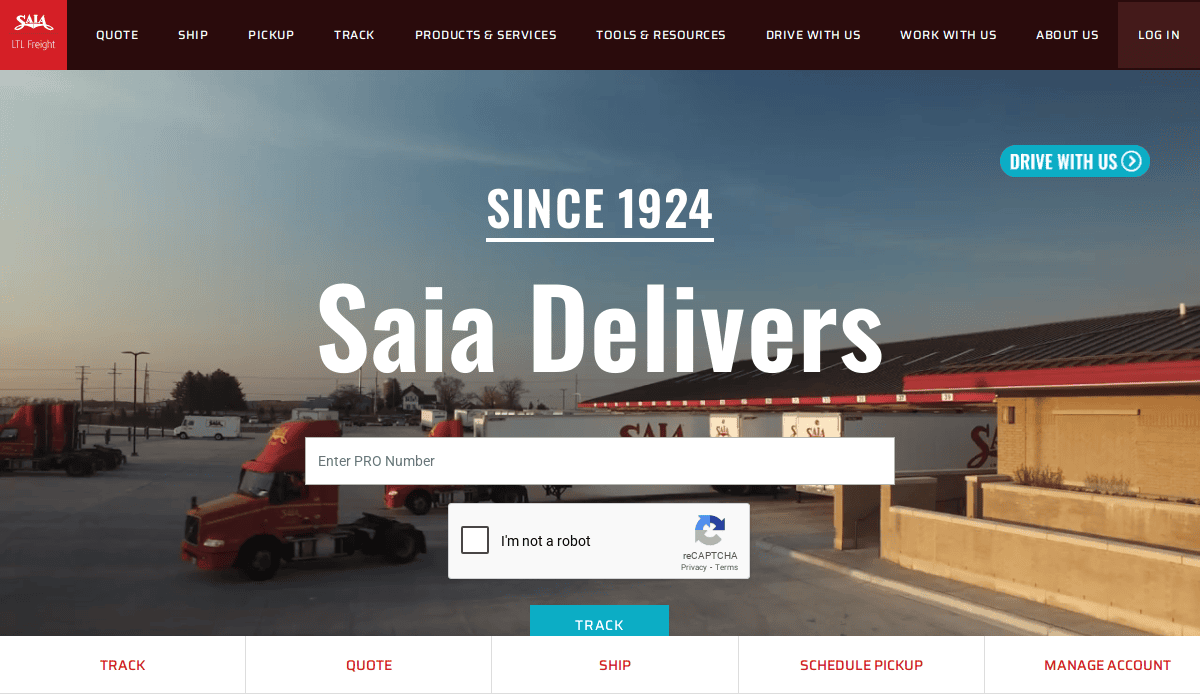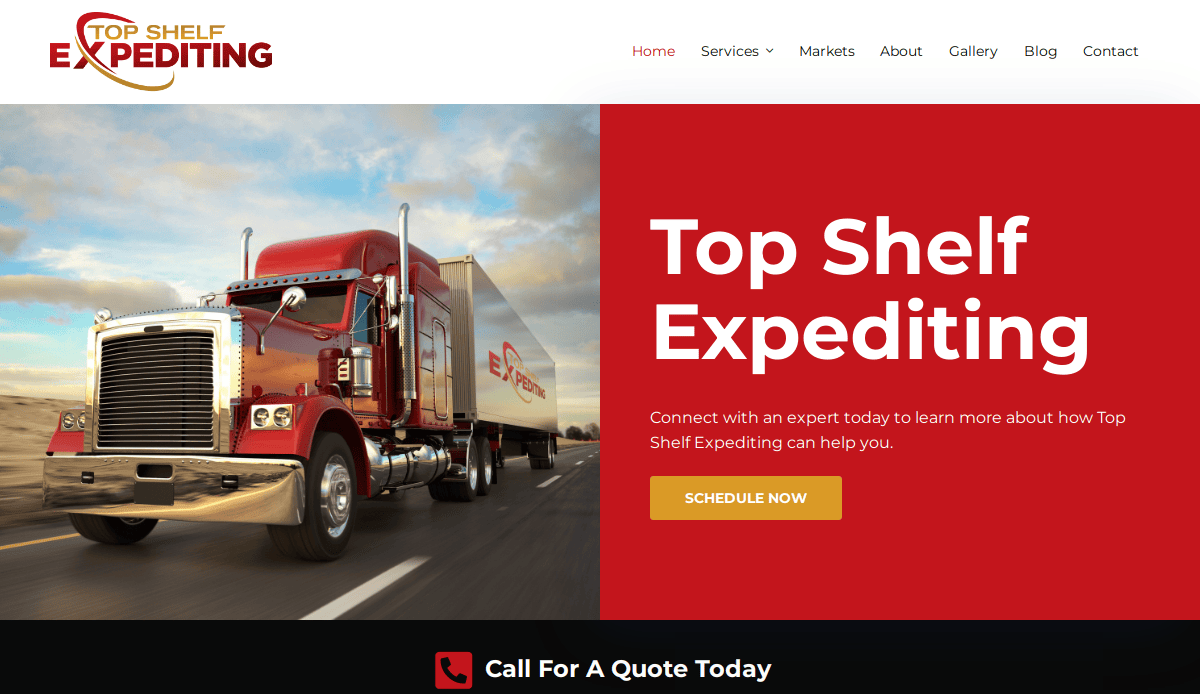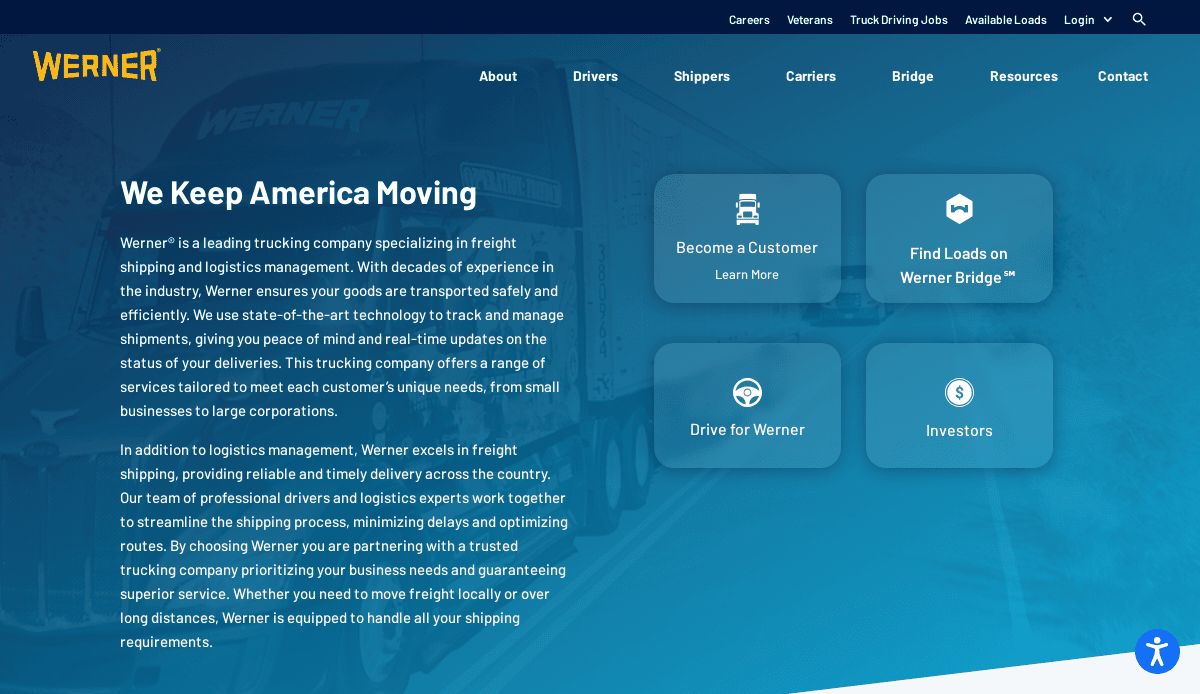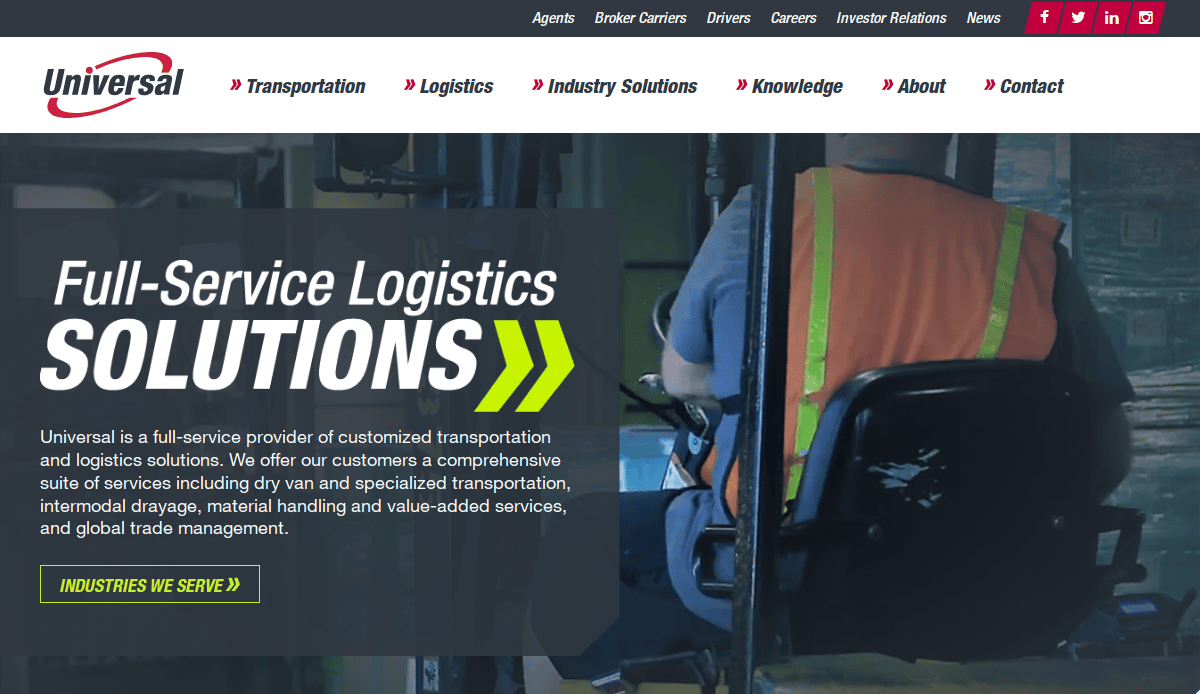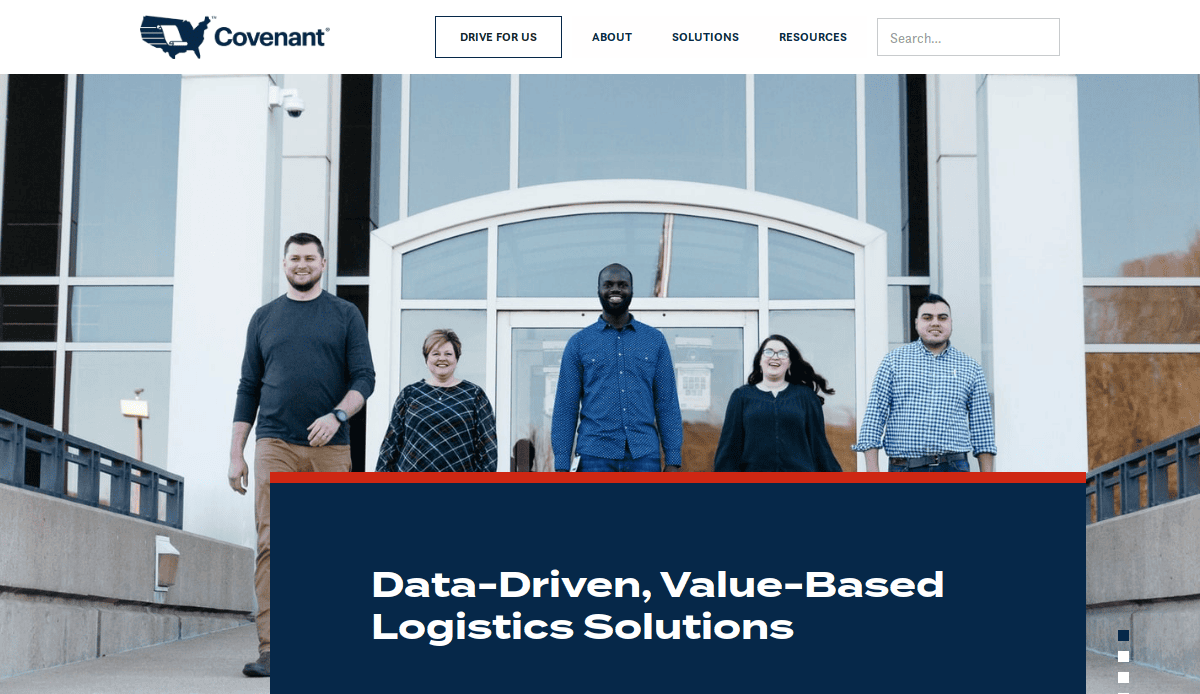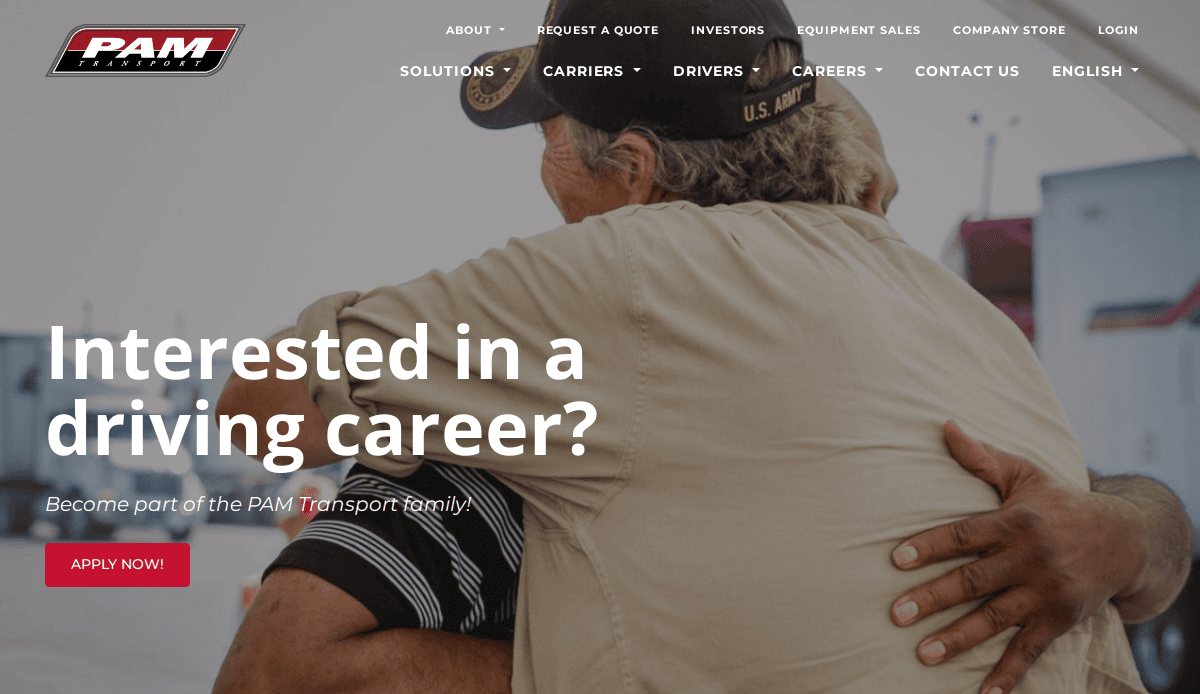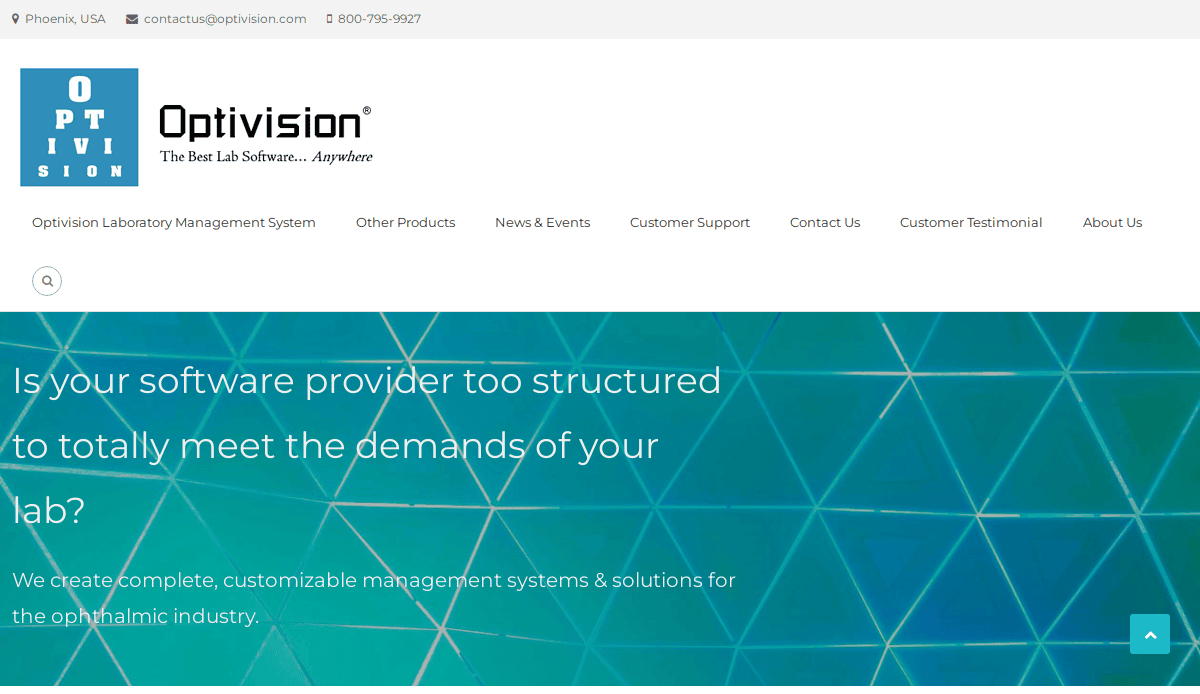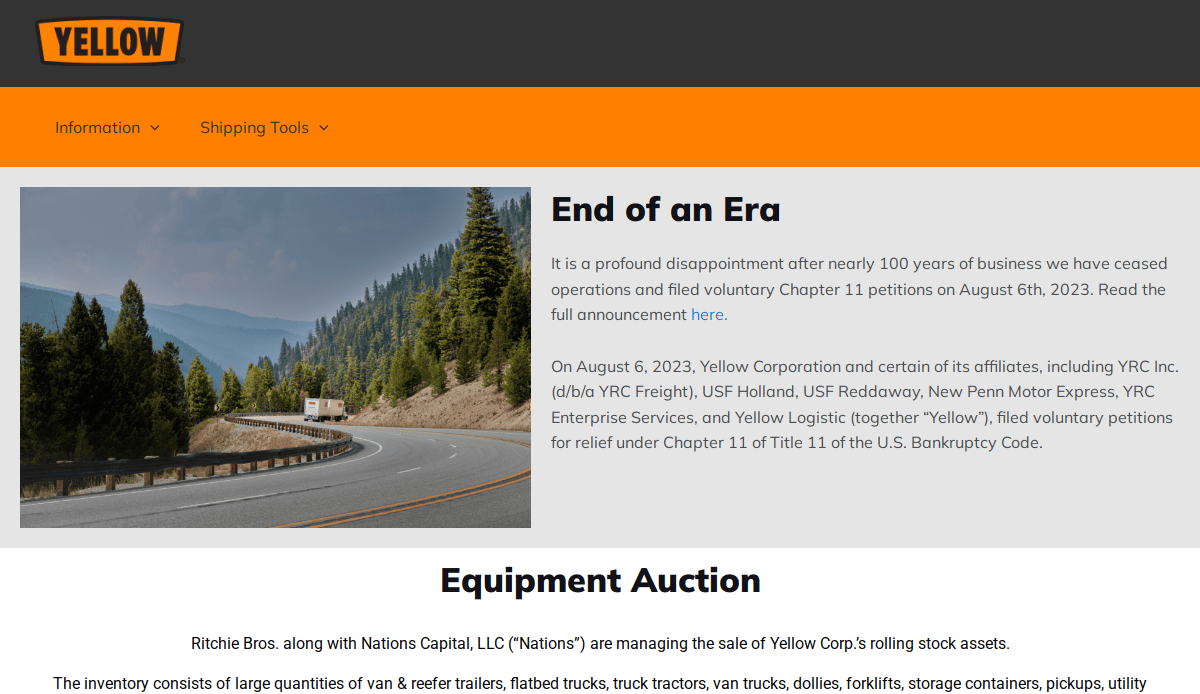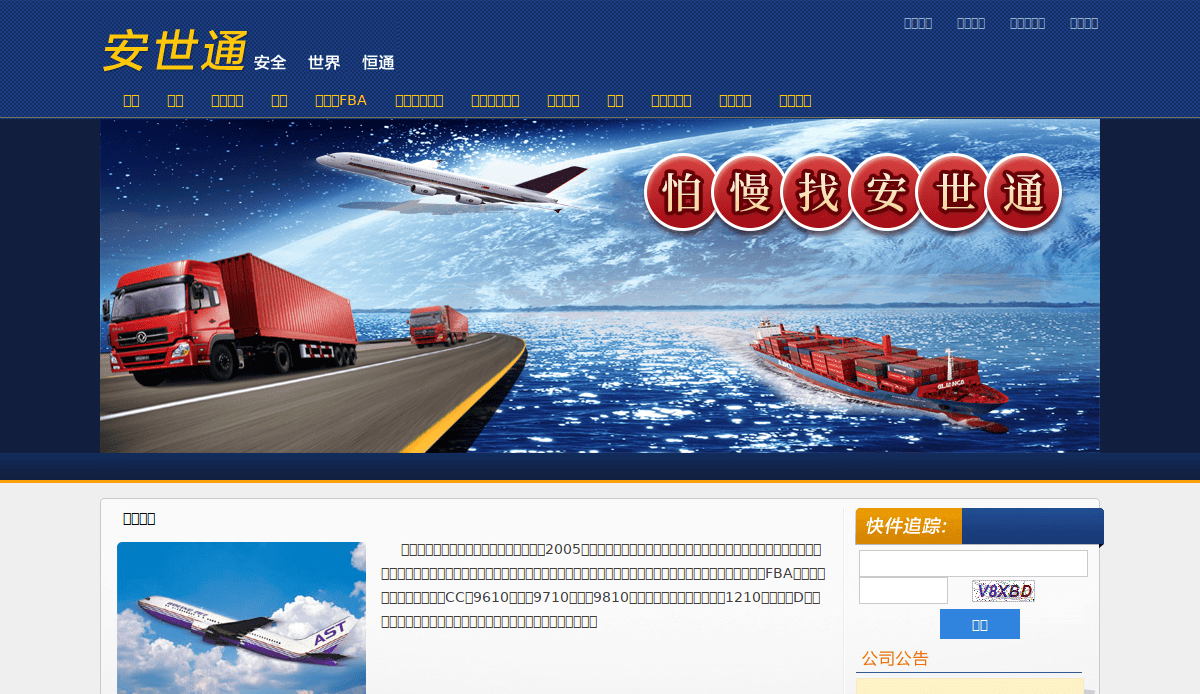Just looking for our Best Transportation Website examples list?
- Strategic design drives conversion– A website isn’t just a digital brochure. It should be designed with strategic user journeys in mind to convert visitors into customers through clear calls-to-action (CTAs), responsive layouts, and intuitive navigation.
- Mobile optimization is non-negotiable– With a growing number of users accessing sites on mobile devices, your website must be fully responsive, load quickly, and present information clearly across all screen sizes.
- Clear branding builds trust– Consistent branding, from color palettes to tone of voice, enhances professionalism and trust. Use real photos of your fleet, team, and facilities to reinforce credibility.
- SEO and content go hand in hand– A well-designed site alone isn’t enough. Combine optimized page titles, meta descriptions, internal linking, and keyword-focused service pages to rank higher and attract qualified traffic.
- Your homepage should answer key questions fast– Visitors should immediately understand who you are, what services you offer, and how to take the next step. Clear messaging and prominent CTAs are essential.
- Testimonials and visuals increase conversions– Social proof, such as client reviews and before-and-after project visuals, plays a key role in influencing decision-making and boosting engagement.
- Accessible design benefits everyone– Ensure your website complies with accessibility standards (like WCAG) to improve usability for all visitors, including those with disabilities.
- Use data to refine and optimize– Regularly review analytics, heatmaps, and A/B testing results to continuously improve your site’s performance, UX, and conversion rates.
- Look to the best for inspiration – Reviewing top transportation websites can spark ideas and help you benchmark your own site’s
Why Your Website Is Your Most Valuable Asset
If your current website feels more like a digital parking lot than a high-performance vehicle, it’s time for an overhaul. In the quick-paced industry of logistics and transit world, a powerful website is more than a nice-to-have — it’s your digital command center. Whether you’re running freight, shipping, or local transit operations, your online presence shapes first impressions, drives leads, and fuels business growth.
Visitors to your website expect more than contact info and a photo of a truck. They want instant access to your services, real-time updates, easy navigation, and a design that reflects your brand’s reliability and scale. A well-executed web design delivers just that — creating confidence, streamlining user journeys, and converting traffic into booked jobs.
We’ll explore the key components of a high-performing transportation website, break down trends shaping the industry, and highlight 19 standout examples to fuel your own site redesign. Whether you’re rebranding or building from scratch, you’ll leave with a clear roadmap to designing a site that moves your business forward.
Website Planning & Purpose: Laying the Strategic Foundation
Before a single pixel is designed or a line of code is written, the foundation of any successful website begins with strategic planning. In the transportation industry, where efficiency and clarity are paramount, your website must serve a defined purpose from the start — whether that’s booking freight, generating service leads, providing live tracking, or showcasing your fleet’s capabilities.
This planning phase isn’t about aesthetics; it’s about aligning business goals with user expectations. It starts with identifying your core audience — logistics managers, business owners, brokers, or even end customers — and mapping out their needs. From there, outline key conversion goals. Should visitors call your dispatch team? Fill out a quote request? Track a shipment? Each of these user intents must have a corresponding path designed into the site.
Competitive analysis is also critical. Look at what other transportation companies are doing — and then do it better. Use tools like heatmaps, analytics, and user flow diagrams to forecast behavior and plan for frictionless navigation. This is the time to define what makes your company unique and how your site can communicate that visually and functionally.
At this stage, successful projects typically include:
- Stakeholder interviews to clarify business objectives
- User journey mapping to plan a logical site structure
- Feature requirement lists, like tracking systems or customer portals
- Brand style guide application to ensure visual consistency
- SEO strategy development tied to services, geography, and competitive keywords
A solid planning phase saves time, avoids rework, and lays the groundwork for a site that delivers measurable results. When done right, the website becomes a performance engine — accelerating engagement, conversion, and growth for your transportation business.
Design Principles: Crafting User-Centered Transportation Experiences
Design is more than aesthetics — it’s a tool for performance. For transportation companies, effective web design helps build credibility, improve navigation, and support conversion goals. The right principles ensure that your site is attractive and purposeful.
- Visual Hierarchy: Use size, contrast, and placement to guide the visitor’s attention. Primary calls-to-action like “Request a Quote” or “Track Shipment” should stand out and appear above the fold.
- Consistency: Maintain consistency in fonts, colors, button styles, and iconography. This creates a seamless brand experience and enhances professionalism.
- Simplicity: Avoid clutter. White space, clean layouts, and a clear content structure help users find what they need quickly, especially when under time pressure.
- Responsive Design: Your website must perform flawlessly on all screen sizes. Mobile users should experience the same ease of navigation and functionality as desktop users.
- Accessibility: Design for everyone. Use proper color contrast, readable fonts, alt text on images, and keyboard navigability to ensure your site meets WCAG standards.
- Speed & Performance: Optimize images, reduce scripts, and use modern frameworks to ensure fast load times. Speed impacts both UX and SEO.
- Navigation Clarity: Use clear, intuitive menu structures with predictable user flows. Include breadcrumbs and a search bar to help users find their way.
- Emotional Impact: Thoughtful visuals, real-life photography, and industry-specific iconography help forge an emotional connection and build trust with your audience.
These principles work together to create a site that feels reliable, authoritative, and easy to use — all essential traits in the transportation industry, where customers value speed, clarity, and dependability.
Content & Navigation: Structuring for Clarity, Speed, and Action
Effective content and navigation are the backbone of any successful website. These two elements determine whether users can easily access the information they need and move through the site with confidence.
Content Structuring: Start with a clear hierarchy. Place essential information like services, contact details, and service areas front and center. Each service should have a dedicated landing page that explains what’s offered, who it’s for, and how to get started. Use headings (H2s and H3s) to break content into scannable blocks. Bullet points, short paragraphs, and icons can help simplify complex logistics topics.
Navigation Strategy: Your main menu should be simple and intuitive, typically including Home, About, Services, Fleet/Equipment, Request a Quote, Contact, and a Blog or Resources section. Use drop-down menus sparingly and ensure each item leads to a high-value page. Add sticky navigation or a back-to-top button for long pages to enhance usability.
Internal Linking: Link related services and blog content together to guide users naturally through your site. For example, a freight service page should link to a case study or blog post about successful deliveries.
Content Tone: The tone should be authoritative yet approachable. Speak directly to the visitor’s concerns — delayed shipments, logistics challenges, unreliable vendors — and position your company as the expert solution. Use industry-specific terminology when appropriate, but define terms for broader audiences.
Call-to-Action Placement: Every page should have a clear next step — call now, request a quote, or schedule a consultation. Place CTAs prominently near the top, in the middle, and at the bottom of key pages.
Footer Navigation: Include essential links in the footer, such as FAQs, Privacy Policy, Careers, and key contact info. A mini sitemap in the footer helps users who scroll to the bottom without finding what they need.
The combination of strong content and strategic navigation improves the user experience, boosts SEO, encourages engagement, and increases the likelihood of conversion.
Visual Elements: Using Imagery to Reinforce Trust and Brand Identity
Visual elements are essential tools that elevate user experience and reinforce your brand identity. In the transportation industry, well-executed visuals communicate scale, reliability, and professionalism while helping visitors understand your services quickly.
Photography: Use high-resolution images of your fleet, logistics operations, and team members. Authentic photos create trust and demonstrate the scope of your capabilities. Avoid generic stock images wherever possible.
Icons & Infographics: Custom icons can simplify complex services such as multi-modal shipping, cargo insurance, or route planning. Infographics are excellent for visualizing step-by-step processes, service tiers, or regional coverage maps.
Video Content: Incorporate short videos showing vehicle loading, warehouse tours, or client testimonials. These enhance engagement and give prospects a more dynamic sense of your company in action.
Color Palette: Choose colors that convey trust and action — blues, grays, and accents of red or green work well in transportation. Stick to your brand guidelines for consistency across all visual content.
Typography: Use clean, legible fonts optimized for web readability. Avoid ornate or overly stylized typefaces, especially for mobile users.
Layout & Spacing: A visually balanced layout with generous white space helps guide users through your content without distraction. Visual breathing room enhances clarity and usability.
Animation & Microinteractions: Subtle hover effects, slide-in panels, or loading animations can make your site feel modern and interactive — just ensure they don’t compromise speed or accessibility.
Effective use of visuals does more than enhance aesthetics — it tells a story, builds emotional resonance, and differentiates your company in a highly competitive field. When visuals align with your brand and business goals, they become a strategic asset in turning visitors into customers.
Ongoing WordPress Maintenance: Keeping Your Site Secure, Fast, and Reliable
A well-designed website is only effective if it stays secure, up-to-date, and fully functional. For logistics and transportation companies that rely on speed and uptime, regular maintenance isn’t optional; it’s critical.
- Security Monitoring: Transportation sites often handle sensitive data such as customer information, tracking details, and payment inquiries. Regular security scans, firewalls, and malware protection help prevent breaches and data loss.
- Software & Plugin Updates: WordPress core, themes, and plugins are frequently updated. Without maintenance, outdated components can break site functionality or create vulnerabilities. Scheduled updates ensure everything works seamlessly.
- Backup Management: Automated daily backups provide peace of mind. In the event of a crash, hack, or hosting issue, you can restore your site quickly and avoid prolonged downtime.
- Performance Optimization: Over time, sites slow down due to bloated databases, unused plugins, and large media files.Ongoing optimization — like image compression, cache clearing, and database cleanup — keeps your site fast and responsive.
- Form Testing & UX Checks: Key conversion forms (e.g., quote requests, contact forms) should be tested monthly to ensure they function across browsers and devices. Regular checks also help spot layout shifts and content issues early.
- SEO Maintenance: Monitor for broken links, 404 errors, slow-loading pages, and indexing issues that can impact your visibility in search engines. Ongoing SEO audits help maintain strong rankings.
- Reporting & Analytics: Monthly performance reports provide insights into traffic trends, user behavior, and goal completions. This data informs smart updates and refinements.
Investing in a WordPress maintenance plan means your website continues to operate at peak performance, offering a dependable, seamless experience for your users, and protecting your digital reputation in a competitive industry.
Best Transportation Website Examples
1. FedEx
- Location: Memphis, Tennessee
- Key Takeaways:
- Clean, intuitive layout with prominent CTAs.
- Robust tracking functionality enhances user engagement.
- Consistent branding reinforces trust and reliability.
2. Greyhound Lines
- Location: Dallas, Texas
- Key Takeaways:
- User-friendly interface for booking and route information.
- Responsive design ensures accessibility across devices.
3. Uber
- Location: San Francisco, California
- Key Takeaways:
- Sleek design with seamless navigation.
- Real-time tracking features improve user experience.
- Integrated services offering versatility to users.
4. XPO Logistics
- Location: Greenwich, Connecticut
- Key Takeaways:
- Professional aesthetic with clear service offerings.
- Interactive elements facilitate user engagement.
- Strategic CTAs guide user actions effectively.
5. Knight-Swift Transportation
- Location: Phoenix, Arizona
- Key Takeaways:
- Modern design with high-quality visuals.
- Detailed content sections enhance information delivery.
- User-friendly interface promoting easy navigation.
6. Old Dominion Freight Line
- Location: Thomasville, North Carolina
- Key Takeaways:
- Clean layout emphasizing core services.
- Strong branding elements build trust.
- Efficient navigation streamlines the user journey.
7. Saia, Inc.
- Location: Johns Creek, Georgia
- Key Takeaways:
- Vibrant design captures user attention.
- Comprehensive service information is readily accessible.
- Responsive design ensures mobile compatibility.
8. Top Shelf Expediting
- Location: Chicago, Illinois
- Key Takeaways:
- Contemporary yet sophisticated aesthetic with a cohesive color palette.
- Streamlined interface simplifies site navigation.
- Prominently positioned “Request A Quote Today” section to engage users.
9. Werner Enterprises
- Location: Omaha, Nebraska
- Key Takeaways:
- Modern design with engaging visuals.
- Clear information architecture facilitates user flow.
- Responsive design ensures accessibility across devices.
10. Marten Transport
- Location: Mondovi, Wisconsin
- Key Takeaways:
- Clean, organized layout enhances readability.
- Strong branding elements reinforce company identity.
- User-centric design promoting engagement.
11. Universal Logistics Holdings
- Location: Warren, Michigan
- Key Takeaways:
- Professional design with clear service offerings.
- Interactive elements enhance user experience.
- Strategic CTAs guide user actions effectively.
12. Heartland Express
- Location: North Liberty, Iowa
- Key Takeaways:
- Minimalist design focusing on core services.
- Strong CTAs encourage user engagement.
- Responsive layout ensures mobile compatibility.
13. Covenant Logistics Group
- Location: Chattanooga, Tennessee
- Key Takeaways:
- Modern design with engaging visuals.
- Clear information architecture facilitates user flow.
- Responsive design ensures accessibility across devices.
14. P.A.M. Transportation Services
- Location: Tontitown, Arkansas
- Key Takeaways:
- Clean, organized layout enhances readability.
- Strong branding elements reinforce company identity.
- User-centric design promoting engagement.
15. Optivision
- Location: Chicago, Illinois
- Key Takeaways:
- Clean and professional design emphasizing information and services.
- Simple yet effective color palette portraying professionalism.
- Visually appealing hero area with a large backdrop image and overlay text.
16. YRC Worldwide Inc.
- Location: Overland Park, Kansas
- Key Takeaways:
- Minimalist design focusing on core services.
- Strong CTAs encourage user engagement.
- Responsive layout ensures mobile compatibility.
17. Zipline
- Location: Chicago, Illinois
- Key Takeaways:
- Modern, dynamic design with an engaging video background.
- Visually appealing design with high-quality photographs.
- Responsive website allowing a seamless browsing experience across devices.
18. Traffic Control Corporation
- Location: Woodridge, Illinois
- Key Takeaways:
- Modern and straightforward visual interfaces with a balanced color scheme.
- Clear alignment with brand identity.
- User-friendly navigation enhances the overall user experience.
19. AST Express
- Location: Chicago, Illinois
- Key Takeaways:
- Sleek and professional layout featuring a vivid orange color scheme.
- Well-organized layout with a user-friendly navigation bar.
- High-quality photos and graphic designs promote services effectively.
These websites exemplify best practices in transportation web design, offering inspiration for creating user-friendly, visually appealing, and functional online platforms in the industry.
Take the Next Step: Let’s Drive Your Website Forward
Your transportation business deserves a website that reflects your reliability, professionalism, and ambition. With the right strategy, design, and ongoing maintenance, your website becomes your hardest-working sales tool — one that drives results 24/7.
Our full-service digital marketing firm has helped transportation companies across the country create websites that deliver measurable growth. Whether you need a full redesign, SEO strategy, or monthly WordPress maintenance, our expert team is ready to help.
Contact us today to schedule your free consultation and accelerate your digital journey.
Your Transportation Site Design Questions Answered
What makes a great transport site stand out?
A standout transport website features a responsive layout, engaging visuals, and strong CTAs like “Request a Quote” or “Track a Shipment.” It should be easy to navigate, represent your brand with a professional logo, and deliver functionality users expect from the best transportation websites.
Are website templates for this industry a good option?
Transportation website templates are a fast, cost-effective starting point. However, they often limit custom features like live tracking or quote calculators. For the perfect transportation web design, a tailored WordPress theme or Webflow setup delivers better long-term value.
Where can I find inspiration for industry-friendly website designs?
Want more inspiration? Browse curated website designs on Dribbble or explore our collection of case studies featuring real businesses with beautiful and effective websites.
Should I consider adding an app to my lineup?
If your services involve real-time updates, GPS routing, or freight tracking, building a mobile app or app integration can enhance usability and customer engagement. Apps are especially effective for public transportation and on-demand logistics providers.
What platforms are ideal for building a website?
WordPress and Webflow are both great options. WordPress themes provide scalability and plugin flexibility, while Webflow allows visual development with advanced animation and illustration capabilities—ideal for modern logistics brands.
How do illustrations improve a transport website’s layout?
Illustrations explain complex logistics processes in a visually engaging way. When paired with real photos, they humanize your site, increase engagement, and visually differentiate your brand in a crowded market.
What’s the best way to structure CTAs?
CTAs should be prominently placed after each major content section, written in active language, and tailored to user needs. For example: “Schedule Your Pickup,” “Track Freight,” or “Request Your Custom Quote.” Learn more about conversion optimization strategies that work.
How should a public transportation site be structured?
Include route maps, schedules, alerts, and fare calculators front and center. Accessibility, responsive layouts, and language options are essential. Clear navigation and minimal clicks-to-info make a huge difference for public transit users.
How important is branding and the logo in web aesthetics?
Your logo is the cornerstone of your visual identity. It should be visible in your header, favicon, and email signatures, ensuring brand consistency. A sharp, professional logo helps build credibility from the first click.
Where can I see examples of perfect transportation website design?
Check out our Transportation Web Design Portfolio to see how we blend functionality with modern design. From custom apps to sleek navigation and on-brand visuals, these examples highlight what’s possible.

